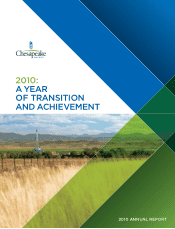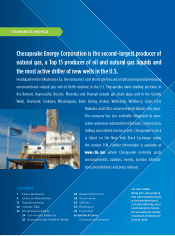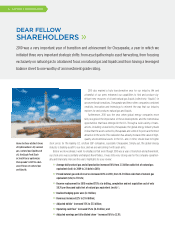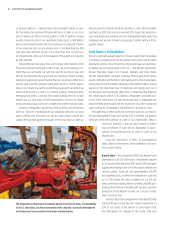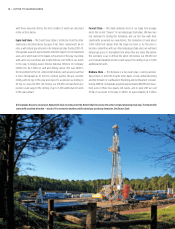Chesapeake Energy 2010 Annual Report Download - page 7
Download and view the complete annual report
Please find page 7 of the 2010 Chesapeake Energy annual report below. You can navigate through the pages in the report by either clicking on the pages listed below, or by using the keyword search tool below to find specific information within the annual report.
vs. an asset gatherer — namely, lower debt and higher returns on capi-
tal. The market has received this plan with favor to date as our stock
price is already up 30% in the first quarter of 2011. In addition, having
recently closed the sale of our Fayetteville Shale assets to BHP Billiton
and recently initiated tender offers for repayment of at least $2.0 billion
of our long-term debt, we are already close to accomplishing the 25%
long-term debt reduction portion of our 25/25 Plan. Now we will focus
on delivering the other part of the equation, 25% growth in production
by year-end 2012.
Beyond the next two years, there will be many other benefits of the
three-way transition we began in 2010. In fact, we are increasingly con-
fident that we can double our cash flow and net income by year-end
2015. By accomplishing these goals and also having our historic trading
multiples expand a bit, we are hopeful that we can achieve a $100 stock
price by year-end 2015, perhaps creating the need for a “100/15” plan in
the process! Clearly it would be an ambitious goal, and to achieve it we
will need the world’s economy to continue growing, China and other
emerging economies to continue their rapidly growing thirst for oil and
natural gas, our new plays to meet expectations, oil prices to remain
strong and natural gas prices not to weaken from where they are today.
However, Chesapeake’s growth from here on will be very mechanical
with our “factories” (meaning both our individual wells and our large
plays) needing only four inputs for success: land, science, people and
capital. We now have gathered enough of these four inputs so that our
factories can run in harvest mode for decades to come, which hopefully
can lead to a $100 stock price by year-end 2015. Again, this would be a
very considerable achievement, but your management team enjoys big
challenges and we look forward to discussing it further with you in the
quarters ahead.
Great Assets = A Great Future
The very significant upward trajectory of value creation that Chesapeake
is on today is primarily driven by the quality of our assets, which feature
dominant positions in 16 of the 20 most important major unconvention-
al natural gas and liquids plays in the U.S. — the Barnett, Haynesville,
Bossier, Marcellus, Eagle Ford, Pearsall, Niobrara and Utica shales
and the Granite Wash, Cleveland, Tonkawa, Mississippian, Bone Spring,
Avalon, Wolfcamp and Wolfberry tight sands and fractured carbonates.
Having only missed the Bakken Shale play in the Williston Basin, having
passed on the Cana Shale play in Oklahoma and having sold out of
the Woodford and Fayetteville shale plays in Oklahoma and Arkansas
(for overall value creation of $5.4 billion), Chesapeake’s unrivaled posi-
tion in the 16 other major U.S. unconventional plays is remarkable and
unprecedented and should form the foundation of further substantial
value creation for Chesapeake’s shareholders for decades to come.
The gathering of these assets has been hard work for our employ-
ees and management team, and during 2010 it stretched our balance
sheet and tested the patience of some of our shareholders. What is
clear now, however, is that we have created a tremen-
dous storehouse of value and an abundance of oppor-
tunities for bountiful harvests for years to come for our
shareholders.
Given the importance of these 16 unconventional
plays, I have provided below a brief summary of our posi-
tion in each of them:
Barnett Shale — Discovered in the 1990s, the Barnett is the
granddaddy of all U.S. shale plays. Chesapeake acquired
its first assets in the Barnett in 2001, and in 2005 we began
aggressively leasing in the core of the play in Johnson and
Tarrant counties. Today we own approximately 220,000
net leasehold acres, on which we estimate we could drill
up to 2,300 future net wells in addition to our 965 net
wells currently producing. We are currently using 18 rigs to
develop this inventory of drillsites and our gross operated
production in the Barnett recently set a record of more
than 1.3 bcfe per day.
Our most important development in the Barnett Shale
during 2010 was closing the joint venture agreement on
25% of our assets in the Barnett to Paris-based Total,
the fifth-largest oil company in the world. Total paid
6 | LETTER TO SHAREHOLDERS
The knowledge and experience Chesapeake gained in the Barnett Shale, the granddaddy
of all U.S. shale plays, has been instrumental in the company’s successful development
of all subsequent unconventional natural gas and liquids plays.

